
Concept explainers
(a)..
To find: The sketch for the graph of the function for which
(a)..
Answer to Problem 55E
The graph is shown in Figure 1 ..
Explanation of Solution
Consider that the function is defined for the limit but not the function is not defined at the point.
The definition of the limit shows that the limit is defined for only for the value of the function is same as the value of x approaches 2 from the left to the right.
Consider the following equation is,
The graph for the above equation is shown in Figure 1
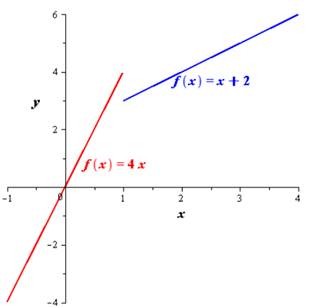
Figure 1
The discontinuity in the curve shows that the limit of the function is not defined at the point
(b)..
To find: The sketch for the graph of the function for which the limit of
(b)..
Answer to Problem 55E
The limit of the function is
Explanation of Solution
Consider the function is,
Press Y and key in the function the display is shown in Figure 2
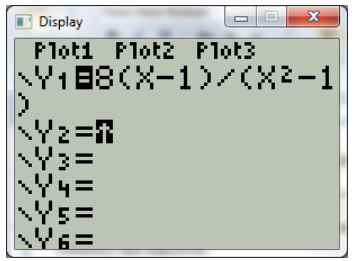
Figure 2
Now press the window button and choose the proper scale as shown in Figure 3
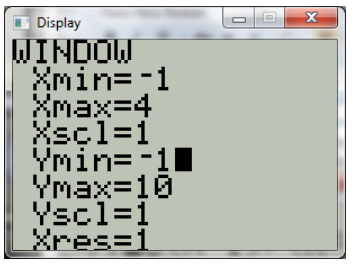
Figure 3
Press the graph button, the graph is shown in Figure 4
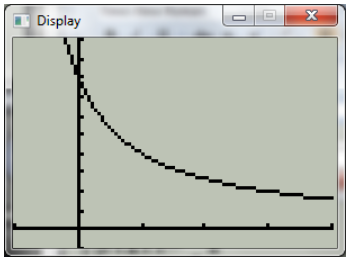
Figure 4
To verify if the function satisfy the given equation press the window button and select ask. The display is shown in Figure 5
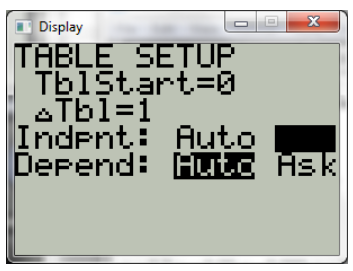
Figure 5
Press the 2nd graph and type in the value in the X column as shown in Figure 6
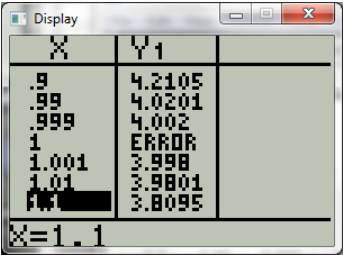
Figure 6
From the table,
Thus, the limit of the function is
Chapter 12 Solutions
EBK PRECALCULUS W/LIMITS
- Use the shell method to find the volume of the solid generated by revolving the region bounded by the curves and lines about the y-axis. y=x², y=7-6x, x = 0, for x≥0arrow_forwardThe graph of f(x) is given below. Select all of the true statements about the continuity of f(x) at x = −3. -7-6- -5- +1 23456 1 2 3 4 5 67 Select the correct answer below: ○ f(x) is not continuous at x = f(x) is not continuous at x = f(x) is not continuous at x = f(x) is continuous at x = -3 -3 because f(-3) is not defined. -3 because lim f(x) does not exist. 2-3 -3 because lim f(x) = f(−3). 2-3arrow_forwardCould you explain how this was solved, I don’t understand the explanation before the use of the shift property As well as the simplification afterwardsarrow_forward
- Question The function f(x) is shown in the graph below. Which of the following statements are true? Select all that apply. f(x) 12 10 -16 -14 -12 -10 -8 + -4 " 10 12 14 16 a Select all that apply: ☐ Condition 1 is satisfied. ☐ Condition 2 is satisfied. ☐ Condition 3 is satisfied. ☐ f(x) is continuous.arrow_forwardFind the equation of the line / in the figure below. Give exact values using the form y = mx + b. m = b = y WebAssign Plot f(x) = 10* log 9 Xarrow_forwardA particle travels along a straight line path given by s=9.5t3-2.2t2-4.5t+9.9 (in meters). What time does it change direction? Report the higher of the answers to the nearest 2 decimal places in seconds.arrow_forward
- Use the method of disks to find the volume of the solid that is obtained when the region under the curve y = over the interval [4,17] is rotated about the x-axis.arrow_forward1. Find the area of the region enclosed between the curves y = x and y = x. Sketch the region.arrow_forwardfor the given rectangular coordinates, find two sets of polar coordinates for which 0≤θ<2π, one with r>0 and the other with r<0. (-2sqrt(3),9)arrow_forward
- I circled the correct answer, could you show me how to do it using divergence and polar coordinatesarrow_forwardThe correct answer is D Could you explain and show the steps pleasearrow_forwardTaylor Series Approximation Example- H.W More terms used implies better approximation f(x) 4 f(x) Zero order f(x + 1) = f(x;) First order f(x; + 1) = f(x;) + f'(x;)h 1.0 Second order 0.5 True f(x + 1) = f(x) + f'(x)h + ƒ"(x;) h2 2! f(x+1) 0 x; = 0 x+1 = 1 x h f(x)=0.1x4-0.15x³- 0.5x2 -0.25x + 1.2 51 Taylor Series Approximation H.w: Smaller step size implies smaller error Errors f(x) + f(x,) Zero order f(x,+ 1) = f(x) First order 1.0 0.5 Reduced step size Second order True f(x + 1) = f(x) + f'(x)h f(x; + 1) = f(x) + f'(x)h + "(xi) h2 f(x,+1) O x₁ = 0 x+1=1 Using Taylor Series Expansion estimate f(1.35) with x0 =0.75 with 5 iterations (or & s= 5%) for f(x)=0.1x 0.15x³-0.5x²- 0.25x + 1.2 52arrow_forward
 Calculus: Early TranscendentalsCalculusISBN:9781285741550Author:James StewartPublisher:Cengage Learning
Calculus: Early TranscendentalsCalculusISBN:9781285741550Author:James StewartPublisher:Cengage Learning Thomas' Calculus (14th Edition)CalculusISBN:9780134438986Author:Joel R. Hass, Christopher E. Heil, Maurice D. WeirPublisher:PEARSON
Thomas' Calculus (14th Edition)CalculusISBN:9780134438986Author:Joel R. Hass, Christopher E. Heil, Maurice D. WeirPublisher:PEARSON Calculus: Early Transcendentals (3rd Edition)CalculusISBN:9780134763644Author:William L. Briggs, Lyle Cochran, Bernard Gillett, Eric SchulzPublisher:PEARSON
Calculus: Early Transcendentals (3rd Edition)CalculusISBN:9780134763644Author:William L. Briggs, Lyle Cochran, Bernard Gillett, Eric SchulzPublisher:PEARSON Calculus: Early TranscendentalsCalculusISBN:9781319050740Author:Jon Rogawski, Colin Adams, Robert FranzosaPublisher:W. H. Freeman
Calculus: Early TranscendentalsCalculusISBN:9781319050740Author:Jon Rogawski, Colin Adams, Robert FranzosaPublisher:W. H. Freeman
 Calculus: Early Transcendental FunctionsCalculusISBN:9781337552516Author:Ron Larson, Bruce H. EdwardsPublisher:Cengage Learning
Calculus: Early Transcendental FunctionsCalculusISBN:9781337552516Author:Ron Larson, Bruce H. EdwardsPublisher:Cengage Learning





